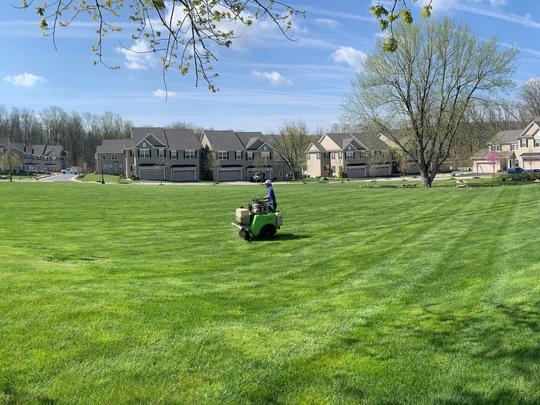
Crabgrass is an ugly annual grass that appears in Pennsylvania when the warmer seasons are back. Turf lovers hate crabgrass because there is nothing loveable about it.
It literally looks like crab legs moving from the center out that proliferate quickly by spreading seeds.
Crabgrass is a weed that can grow back every year. If you do not take care of this weed, it will keep growing throughout the seasons. You will still see that horrible crabgrass late fall.
Try to mow it short, and it will adjust by growing flat.
Once it reaches its maturity somewhere during mid-summer, each plant produces a few hundred thousand seeds that will germinate the following year.
And there is more.
Crabgrass Will Come Back
The frost will kill the plants, but not the crabgrass seeds. Typically, they will germinate the following year during the warmer season as soon as soil temperature averages fifty-five degrees for five consecutive days in Chester County, PA.
Although not all seeds will germinate, some will and progressively take over your lawn.
Crabgrass is the natural nemesis of procrastinators. In other words, the more you wait in the season, the greater the problem. So, the best tip we can share is not to wait to prevent that weed from spreading.
After reading all the above, if you can see crabgrass on your lawn, you may wonder if humankind has met its champion and if any resistance is worth it?
Have no fear.
Crabgrass has no place on your lawn if you love your lawn strong enough. Hence, you may need to implement a thorough weed control strategy targeting crabgrass.
How to do that? Read on.
Take These Steps Against Crabgrass
It is essential to time your crabgrass control approach to successfully prevent growth:
- When seeds are on the verge of germinating in March, apply a pre-emergent herbicide. Some of these herbicides are either liquid or granules, offering a protective barrier that will kill crabgrass before it settles.
- Apply a post-emergent herbicide from June to October if you notice crabgrass growing on your lawn. Post-emergent herbicides take care of weeds that have germinated or reached a certain degree of maturity in their growth cycle.
- If you do not like the chemical stuff or cannot hire a lawn care company, you can pull the weeds manually, but ensure that the root system comes out of the ground during the removal process. Try to do that early summer. Then, fill the hole created and replant lawn seeds. Usually, this approach is okay only if you have a limited number of weeds because this process is involved.
There are other considerations to successfully control weed development that are not only specific to crabgrass, but that will help a great deal in this case.
Use Crabgrass Prevention Best Practices
Here are some more things you can do to give a hard time to crabgrass:
- Do not mow your lawn too short. We recommend that you do not cut your lawn under three and a half inches for two reasons: Crabgrass will grow flat if you cut it short, and taller lawn plants will make weed growth more challenging.
- Apply the right amount of fertilizer, and avoid any excess application; otherwise, you may overpower weeds, which is not what you want. If you need to learn more about how to fertilize your lawn, we have some resources available here.
- Do not water your lawn too frequently or excessively to avoid weakening your healthy lawn plants while reinforcing weeds.
- Implement regular lawn maintenance and apply best lawn care practices. Healthy lawn plants will grow more robust and create territorial competition with weeds.
- Remove dead crabgrass from your lawn. Never leave dead weeds to help your lawn recover faster. You may even consider reseeding bare spots.
Like any other weed, remember that you are running a marathon against crabgrass, so consistency should be the keystone of your lawn care approach.
Your Takeaways
Consider pre-emergent and post-emergent applications as part of your lawn care strategy if you need results. These formulations can be chemical or organic, depending on your preference.
Make sure to time properly these applications because hitting crabgrass at the right time in its growth cycle will help eliminate it.
Ultimately apply best practices of lawn care to your lawn consistently. If you feel overwhelmed by the work involved, contact us for more information.
